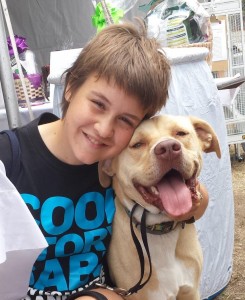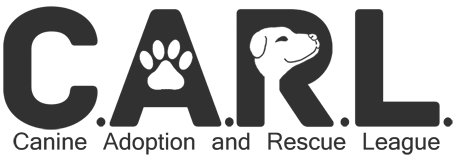The Joys of Fostering at CARL, Part 2 – Moving In Together
- 2014-07-28
- By Kathy King
- Posted in Volunteer

People enter the foster community in a variety of ways. A few have an interest of adopting “sometime” in the future, and fall head-over-heels in love the first day! Many are in the service of re-homing for the long run, and consider themselves more-or-less proprietors of a bed & breakfast for dogs. No matter how you start out, the situation is the same; YOU are the focal point of a dog’s life, and you can have a profound impact on her future.
Before you bring a canine into your home, be honest with yourself and clear with family members. If you are absolutely certain you are not interested in adopting, be aware that you are giving guidance to a pet for another family. Set boundaries that should be consistent so there is no confusion for the dog. Before we look at the dog needs and wants, let’s address what she does not need. If you are not going to be the forever home, use pet beds, not yours. If the next family wants to sleep with the dog, let it be THEIR prerogative and joy to share. The same can be said of large dogs on furniture, or “spoiling” the dog by feeding it scraps from your plate so she watches while you eat and waits to be fed. Dogs need “good” manners when looking for a new home. Please do not create habits that might get them returned.
The first day: Anticipate the need for a tour of the house, meeting family and neighbors, using the yard for potty. Try to keep the interactions simple and safe.
- ALWAYS be cautious when near the door. The first day is the most dangerous for losing a fearful or curious dog. They do not know where they live and can become confused. Make sure you ALWAYS use a leash, and the collar or harness is fitted properly to your dog’s body. If the dog does get out and is lost, IMMEDIATELY inform the rescue that this happened. The sooner you can get help, the better.
- If introducing the foster to a new pet, a plan should already be in place. Be flexible about sleeping arrangements during the early phase of integration. Never rush, and use common sense. ALL new introductions, human and animal, always require supervision!
- Of course a bed and water need to be always present. You might have a list with the food she had been eating. Please try to follow any unique instructions related to this particular dog. If you do not understand, or forgot to ask in the excitement anything health related; CALL.
As we saw in PART 1, different dogs might require different over-all needs. Let’s look at those groups again. Remember this is a generalization, and there might be multiple issues that need to be addressed. Or not. Dogs can be just as complex as people.
Seniors might need a nurturing environment to assure them that they are loved and safe. Losing a long term home and family is always stressful. They can suffer from depression and anxiety just like us. Some might need medications for arthritis etc. If you have questions about their health, always ask your point person at the rescue. It might be normal for that dog, or it could be something that needs medical attention. Most are usually calmer, house broken, know their basic commands. They are so appreciative of having a person of their own to love again, that they play like puppies!
Little dogs need allowances for their size. A smaller bed can give a better sense of security. As will a blanket to tuck under. They are lap dogs, and might need help onto furniture for cuddling. Do not forget how fragile little bones are; so correct and supervise children. Having a small one is in many ways much easier than large dogs. They eat less so it is easier at meal time, weigh less so if in a tussle with another dog you can usually just pick them up, and they might leave room for you on the sofa!
Hospice means end of life with dignity. Not the end of YOUR life. Consider scheduling blocks of time for fellow volunteers to give you some time for yourself. If this dog has been at a rescue for a while, she will have a few favorite friends. This will also allow for visits to the dog that will make her day special! From birth to death, dogs are companion animals; they crave a sense of belonging in a family unit. Just a quiet place to sleep the last few days on this earth, would be a kindness to some that have never had a home.
Moms and Puppies can be very busy before you know it. At first they will need a quiet place to nurse and be safe from general every day commotion. As the puppies get bigger, the Mom will need a bit more time to take breaks, for eating and potty. Socialization is an important element for the pups. As is working with a vet for the puppy shots, and the Mom’s health care will include spay when ready. Puppies will need to be spay/neutered as well. But as serious as that is, they steal hearts with cuteness; and are always the stars of the adoption days!
Large dogs are expected to always live by a higher standard. By that, I mean people are less tolerant of their poor behavior. The biggest improvement that can get a dog adopted, is good leash manners. Walks are good for sensory fulfillment, as well as exercise. If possible, work at the basic commands: sit, down, stay, and leave it. Once a dog “wants” to learn, it can be very fun for you both!
Hopefully this might help you in your decision to foster a dog in need. The better prepared you are, the easier transition everyone will have. Then you can better enjoy one of the most rewarding experiences you will ever have volunteering!
Recent Posts
- Mountain Fire
- Thank you Showtime Photo Booth
- Thank You Briggs School
- Thank You Donna Avery!
- A sibling affair: twins earn top scouting awards together
Recent Comments
- Kelli on In Loving Memory of Yoda
- Genie Tuttle on When a Walk Won’t Do
- Jan Jackson on CARL Rescues 11 Dogs from Yulin Dog Meat Festival
- Letty on CARL Rescues 11 Dogs from Yulin Dog Meat Festival
- Grace Cunningham on Lowe’s HEROES Improving Our Communities
Archives
- November 2024
- October 2024
- February 2024
- October 2019
- July 2019
- June 2019
- January 2019
- September 2018
- March 2018
- May 2017
- March 2017
- February 2017
- November 2016
- October 2016
- September 2016
- July 2016
- June 2016
- May 2016
- March 2016
- February 2016
- January 2016
- December 2015
- October 2015
- September 2015
- July 2015
- June 2015
- May 2015
- March 2015
- February 2015
- January 2015
- December 2014
- November 2014
- October 2014
- September 2014
- August 2014
- July 2014
- June 2014
- May 2014
- April 2014
- March 2014
- February 2014
- January 2014
- December 2013
- October 2013
- August 2013
- July 2013
- April 2013
Categories
- Canine Health and Diet
- Donate
- Donations
- Event
- Foster
- Fundraising
- Humane Education
- Media
- Pet Safety
- Pooch Parade
- Press Releases
- Rescue Story
- Senior Dogs
- Training
- Volunteer
